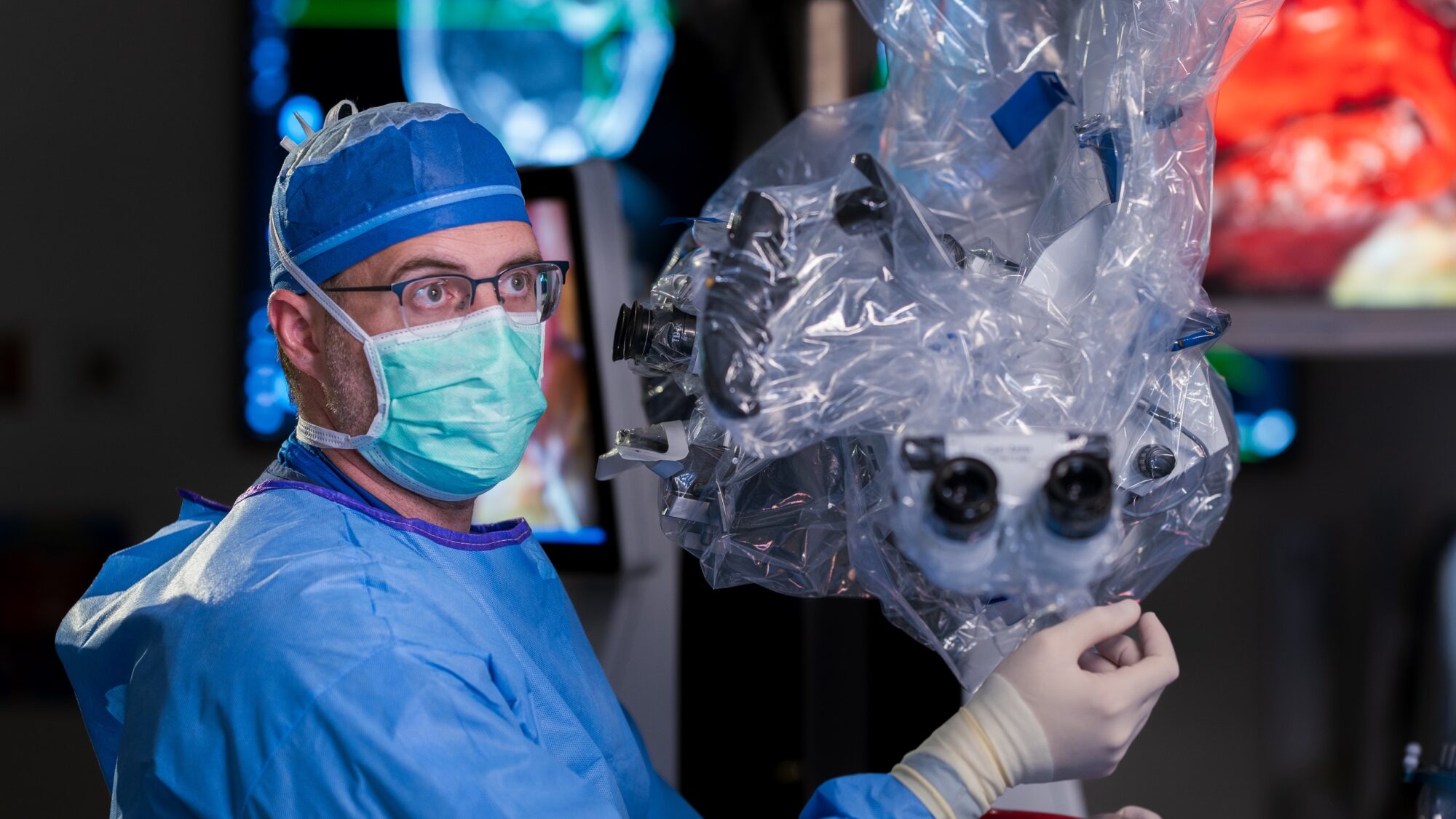
Cholesteatoma
Overview
A cholesteatoma is an abnormal, noncancerous growth of skin cells trapped in the middle ear, behind the eardrum.
The term cholesteatoma refers to skin growing behind the eardrum and into other spaces, such as the middle and inner ear. While not technically a tumor, a cholesteatoma can, in many ways, behave like one and can cause significant damage to vital structures, including the eardrum, hearing bones, ear canal, and inner ear (cochlea).
There are two types of cholesteatomas:
- A congenital cholesteatoma occurs at birth due to embryonic tissue trapped in the middle ear during fetal development.
- An acquired cholesteatoma develops later in life, often due to chronic ear infections or eustachian tube dysfunction.
The eustachian tube helps equalize pressure in the middle ear by connecting it to the back of the throat. When it’s not working correctly, negative pressure builds and can pull some of the eardrum inward, creating a pocket or cyst that fills with old skin cells. In turn, this pocket or cyst can enlarge or become infected, leading to the breakdown of middle ear bones or other vital structures.
A cholesteatoma can also cause ear pain, ear drainage with a foul smell, hearing loss, and dizziness. It can also cause permanent functional damage to the ear and permanent hearing loss in the affected ear and, in rare circumstances, be life-threatening if left untreated.
What causes cholesteatoma?
Chronic ear infections or congenital factors most often cause cholesteatomas. However, they can also result from eustachian tube dysfunction and, infrequently, ear trauma or surgery.
- Chronic ear infections: Reoccurring ear infections can lead to negative pressure in the middle ear and cause the eardrum to retract. This creates a pocket inside the ear that traps skin cells and other debris and forms a cholesteatoma.
- Congenital cholesteatoma: Congenital cholesteatoma is a rare condition present at birth due to embryonic tissue trapped in the middle ear during in-utero development.
- Poor ventilation: The eustachian tube connects the middle ear to the back of the nose and throat, called the nasopharynx, and helps ventilate the area. A cholesteatoma can develop when the eustachian tube isn’t working optimally for a prolonged period—for example, due to allergies or recurrent sinus infections.
- Perforated eardrum: A hole or tear in the eardrum can allow skin cells to enter the middle ear and lead to a cholesteatoma.

Cholesteatoma Symptoms
While skin growing behind the eardrum can sound relatively innocuous, a cholesteatoma can lead to severe complications if left untreated.
Symptoms you might notice if you or someone you know has a cholesteatoma can include:
- Hearing loss: Although it may be gradual, hearing loss will be progressive and typically affects one ear
- Ear discharge: Chronic and persistent drainage from the ear that may be foul smelling
- Dull ear pain: Persistent ear pain or discomfort that does not subside with typical treatments
- Ear fullness or pressure: Sensations of ear fullness or pressure can be present in the affected ear
- Tinnitus: Experienced as a ringing or buzzing in the ear, tinnitus presents as a symptom of an underlying condition, like a cholesteatoma
- Mild dizziness or vertigo: Problems within the inner ear can present as dizziness or a spinning sensation, such as vertigo
- Ear infections: Frequent infections that may not respond well to typical treatments
- Facial muscle weakness: In rare cases, facial weakness can occur if the cholesteatoma grows large enough to affect the facial nerve
If you’ve been diagnosed with a cholesteatoma or are experiencing symptoms that concern you, we recommend contacting a trusted healthcare professional or our Surgical Neurotology Program at Barrow Neurological Institute. We’ll promptly schedule you for a consultation with one of our highly skilled neurotologists.
Diagnosis
Fortunately, diagnosing a cholesteatoma is relatively uncomplicated. If you’re experiencing any of the symptoms outlined above, your healthcare provider will refer you to an ear, nose, and throat (ENT) specialist, where one or more of these exams and imaging tests will be used:
- Physical exam: First, your ENT specialist will thoroughly examine your ears using an otoscope, an instrument with a light and magnifying lens. They’ll look for signs of cholesteatoma, like an abnormal growth or a perforated eardrum. In some cases, the specialist may use a small, flexible camera called an endoscope to examine the ear more closely and assess the extent of your cholesteatoma.
- Hearing tests: To assess the range of hearing loss, your specialist will order an audiogram, as well as any other accessory hearing tests, to determine if the cholesteatoma affects your hearing.
- Computed tomography (CT) scan: A CT scan of the temporal bone surrounding the ear will provide detailed images of your ear structure using multiple X-rays from different angles combined into one image. This, in turn, determines the size and extent of the cholesteatoma and whether it has damaged the surrounding structures, like the inner ear.
- Magnetic resonance imaging (MRI): In some cases, an MRI may provide more detailed imaging of soft tissues to help differentiate cholesteatoma from other types of masses or lesions.
- Balance tests: If you have symptoms of vertigo or balance issues, balance testing can determine if the cholesteatoma affects the inner ear structures responsible for equilibrium.
Used as needed, these diagnostic tests will help your healthcare team create the right cholesteatoma treatment plan for you.

Cholesteatoma Treatments
Treatment for cholesteatoma most often involves surgery to provide a safe, dry ear and prevent further complications. Rarely, your ENT specialist may manage a small cholesteatoma with regular follow-up care, cleanings, and eardrops. As with any condition, the specific approach will depend on the cholesteatoma’s size and location.
Surgical Treatments
- Mastoidectomy: The most common surgical procedure, a mastoidectomy involves removing the cholesteatoma and any infected or damaged tissue from the mastoid bone and middle ear. Your surgical neurotologist may need to reconstruct parts of the ear using grafts or prosthetic materials. At Barrow, our surgeons are experts in performing this procedure. They will counsel you on variables unique to your case and the anticipated outcomes following surgery.
- Tympanoplasty: This procedure repairs the eardrum or tympanic membrane by using cartilage or muscle from another part of the ear to fill holes in the eardrum. It can also involve reconstructing the middle ear’s small bones, or ossicles, to improve hearing.
- Canal wall-up surgery versus canal wall-down surgery: Canal wall-up surgery preserves the ear canal’s natural structure. In contrast, canal wall-down surgery involves removing part of the ear canal wall to ensure complete cholesteatoma removal and reduce the risk of recurrence. The specific choice of procedure depends on your case and your surgeon’s preference. Still, both aim for the same objective: completely removing your cholesteatoma.
Your surgical neurotologist will prescribe antibiotics before surgery if you have an active infection. Your surgeon will also clean the ear canal to remove debris and drainage. Regarding postoperative care, regular follow-ups will be crucial to monitor for signs of recurrence. Most cholesteatoma surgeries are outpatient procedures, but in some cases, a short hospital stay of 24 to 48 hours may be required.
Because cholesteatomas are highly prone to recurrence, two procedures may be required to cure your condition fully. This process, called surgical staging, has become a standard of care in treating cholesteatomas and is associated with the best possible outcomes in terms of curing the underlying disease and restoring a degree of normal hearing.
As with any surgical procedure, there are inherent risks, including tinnitus, imbalance or vertigo, facial weakness, and additional hearing loss. For those experiencing hearing loss, rehabilitation is often recommended after surgery, such as hearing aids or reconstruction of damaged ossicles—the tiny bones in the middle ear—to help boost hearing.
Common Questions
How common is cholesteatoma?
Cholesteatoma is a relatively uncommon condition: only nine out of every 100,000 adults in the U.S. are diagnosed with it, while the incidence rate in children is about 3 per 100,000 children.
Additionally, congenital cholesteatoma is very rare, with estimates suggesting it occurs in about 1 in 10,000 live births. Congenital cholesteatoma is when an infant is born with a cholesteatoma because of developmental abnormalities in the womb.
Who gets cholesteatomas?
Cholesteatoma can affect people of any age, gender, or ethnicity, but certain groups are at higher risk. People prone to ear infections and other ear-related problems are at higher risk for acquired cholesteatomas. Chronic sinus conditions and allergies can also contribute to eustachian tube dysfunction, increasing the likelihood of cholesteatoma.
While cholesteatomas can develop at any age, they are often diagnosed in children and adolescents, particularly congenital cholesteatomas or those resulting from recurrent infections. Acquired cholesteatomas are more common in adults, especially those with chronic ear problems.
As a whole, cholesteatomas are slightly more common in males and those with a cleft palate, as children with craniofacial abnormalities frequently experience Eustachian tube dysfunction.
What is the prognosis?
The prognosis for people with a cholesteatoma can vary based on the size and extent of the cholesteatoma, the presence of complications, and the effectiveness of the treatment. The prognosis is generally good if the cholesteatoma is small and confined to the middle ear. Cholesteatomas that are large and have spread throughout critical structures can be more challenging to treat.
Early detection and surgical intervention often lead to favorable outcomes. However, cholesteatomas tend to recur, so ongoing monitoring and follow-up care are required for the best prognosis. With proper treatment and management, most people with cholesteatomas can significantly improve their symptoms and quality of life.
How long will I need to recover after surgery?
For the first few days after surgery, pain and discomfort should be well-managed with prescribed medications. Ear popping or cracking noises and mild dizziness may occur, and the temple and area around the eye socket on the affected side may also experience swelling.
In the following week, it’s essential to rest and avoid strenuous activities. Most people can return to light activities within a few days but should avoid heavy lifting or straining. Your surgeon typically schedules a follow-up visit within the week to check the surgical site and remove the packing material used to promote wound healing. It’s critically important to keep water out of the ear canal during this time. Some temporary hearing loss may occur, but hearing changes and improvements will continue to be monitored during follow-up visits.
After four to six weeks, most people can gradually resume normal activities, including work or school. It’s important to note that postoperative dressings are often required for one to two months after surgery. Around this same time, your doctor will schedule a hearing test to assess changes in hearing and determine if additional treatments, like hearing aids, are needed.
After surgery, anywhere from six to 12 monthly follow-ups are needed to monitor for cholesteatoma recurrence, while some patients require lifelong follow-ups.
Can cholesteatoma be prevented?
While preventing all cholesteatomas is not possible, reducing the risk of those caused by chronic ear infections is. Preventative steps include:
- Prompt treatment of ear infections: For reoccurring or prolonged middle ear infections, seek treatment as soon as possible. Use the prescribed antibiotics and eardrops to reduce inflammation, clear infections, and prevent a cholesteatoma from forming.
- Address eustachian tube dysfunction: Managing conditions that cause eustachian tube dysfunction—allergies, sinus infections, or nasal congestion—can help maintain proper middle ear pressure, as eustachian tubes connect your middle ears to the back of your throat. Your doctor might recommend nasal decongestants or antihistamines to alleviate congestion and improve eustachian tube function.
- Regular monitoring: Early intervention and regular check-ups with an ear, nose, and throat (ENT) specialist, preferably with specialty training in surgical neurotology, will help those with a history of ear infections detect concerns before progressing to a cholesteatoma. Periodic hearing tests can also help identify any changes in hearing that might indicate a cholesteatoma.
- Avoiding ear trauma: Protecting the ears from trauma, such as inserting objects into the ear canal and causing eardrum perforation, can help prevent cholesteatomas from forming.



